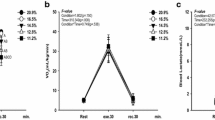Abstract
The effect of acute hypoxia on the human left ventricular function during exercise was evaluated by 2D and Doppler echocardiography on 11 healthy male college students. Each subject completed 6-min moderate intensity (100 W) supine cycling exercises in normoxia and hypoxia, respectively. The concentration of inspired O2 was adjusted to keep arterial hemoglobin O2 concentration (SpO2) at 88–92% during hypoxia. Doppler indices obtained were compared between normoxia and hypoxia. The left ventricular myocardial diastolic function was increased during exercise in hypoxia compared with normoxia. The peak velocity of early filling wave increased at rest (P < 0.05) and during exercise (P < 0.05 at second minute, and P < 0.01 at sixth minute) in hypoxia. The heart rate (P < 0.01) and cardiac output (P < 0.001) were elevated markedly at rest during hypoxia. The left ventricular systolic function variables, such as stroke volume, ejection fraction, and end-systolic volume were relatively unaltered during hypoxia compared with normoxia. The results suggest that acute hypoxia increases the left ventricular myocardial diastolic function during moderate intensity supine cycling exercise without affecting the systolic function.

Similar content being viewed by others
References
Angermann M, Hoppeler H, Wittwer M, Dapp C, Howald H, Vogt M (2006) Effect of acute hypoxia on maximal oxygen uptake and maximal performance during leg and upper-body exercise in Nordic combined skiers. Int J Sports Med 27:301–306
Boussuges A, Molenat F, Burnet H, Cauchy E, Gardette B, Sainty JM, Jammes Y, Richalet JP (2000) Operation Everest III (Comex’97): modifications of cardiac function secondary to altitude-induced hypoxia. An echocardiographic and Doppler study. Am J Respir Crit Care Med 161:264–270
Calbet JA, Boushel R, Radegran G, Sondergaard H, Wagner PD, Saltin B (2003) Determinants of maximal oxygen uptake in severe acute hypoxia. Am J Physiol Regul Integr Comp Physiol 284:291–303
Cheng CP, Igarashi Y, Little WC (1992) Mechanism of augmented rate of left ventricular filling at rest and during exercise. Circ Res 70:9–19
Cheng CP, Noda T, Nozawa T, Little WC (1993) Effect of heart failure on the mechanism of exercise induced augmentation of mitral valve flow. Circ Res 72:795–806
Ferretti G, Licker MJ, Anchisi S, Moia C, Susta D, Morel DR (2005) The effects of beta1-adrenergic blockade on cardiovascular oxygen flow in normoxic and hypoxic humans at exercise. Eur J Appl Physiol 95:250–259
Friedmann B, Frese F, Menold E, Bartsch P (2005) Individual variation in the reduction of heart rate and performance at lactate thresholds in acute normobaric hypoxia. Int J Sports Med 26:531–536
George K, Oxborough D, Forster J, Whyte G, Shave R, Dawson E, Stephenson C, Dugdill L, Edwards B, Gaze D (2005) Mitral annular myocardial velocity assessment of segmental left ventricular diastolic function after prolonged exercise in humans. J Physiol 15:305–313
Gledhill N, Cox D, Jamnik R (1994) Endurance athletes’s stroke volume does not plateau: major advantage is diastolic function. Med Sci Sports Exerc 26:1116–1121
Goodman JM, McLaughlin PR, Liu PP (2001) Left ventricular performance during prolonged exercise: absence of systolic dysfunction. Clin Sci (Lond) 100:529–537
Green DJ, Naylor LH, George K (2006) Cardiac and vascular adaptations to exercise. Curr Opin Clin Nutr Metab Care 6:77–84
Gueret P, Meerbaum S, Wyatt HL, Uchiyama T, Lang TW, Corday E (1980) Two-dimensional echocardiographic quantitation of left ventricular volumes and ejection fraction. Importance of accounting for dyssynergy in short-axis reconstruction models. Circulation 62:1308–1318
Hinckson E, Hopkins W, Downey B, Smith B (2005) The effect of intermittent hypoxic training via a hypoxic inhaler on physiological and performance measures in rowers. J Sci Med Sport 8(Suppl 4):60–61
Hopkins SR, Bogaard HJ, Niizeki K, Yamaya Y, Ziegler MG, Wagner PD (2003) Beta-adrenergic or parasympathetic inhibition, heart rate and cardiac output during normoxic and acute hypoxic exercise in humans. J Physiol 550:605–616
Leuenberger UA, Brubaker D, Quraishi S, Hogeman CS, Imadojemu VA, Gray KS (2005) Effects of intermittent hypoxia on sympathetic activity and blood pressure in humans. Auton Neurosci 121:87–93
Levine BD (2002) Intermittent hypoxic training: fact and fancy. High Alt Med Biol 3:177–193
Libonati JR (1999) Myocardial diastolic function and exercise. Med Sci Sports Exerc 31:1741–1747
Libonati JR (2003) Exercise and diastolic function after myocardial infarction. Med Sci Sports Exerc 35:1471–1476
Lusina SJ, Kennedy PM, Inglis JT, McKenzie DC, Ayas NT, Sheel AW (2006) Long term intermittent hypoxia increases sympathetic activity and chemosensitivity during acute hypoxia in humans. J Physiol 575:961–970
Mazzeo RS, Reeves JT (2003) Adrenergic contribution during acclimatization to high altitude. Exerc Sport Sci Rev 31:13–18
Morton JP, Cable NT (2005) Effects of intermittent hypoxic training on aerobic and anaerobic performance. Ergonomics 48:1535–1546
Roels B, Millet GP, Marcoux CJ, Coste O, Bentley DJ, Candau RB (2005) Effects of hypoxic interval training on cycling performance. Med Sci Sports Exerc 37:138–146
Wolfel EE, Selland MA, Mazzeo RS, Reeves JT (1994) Systemic hypertension at 4,300 m is related to sympathoadrenal activity. J Appl Physiol 76:1643–1650
Acknowledgments
We thank the subjects who participated in the study. Thanks to Prof. Liu Xuezhen and Prof. Xu Disheng for their valuable advices on statistical methods. Thanks to Mrs. Kaili for her help on English grammar.
Author information
Authors and Affiliations
Corresponding author
Rights and permissions
About this article
Cite this article
Yan, B., Hu, Y., Ji, H. et al. The effect of acute hypoxia on left ventricular function during exercise. Eur J Appl Physiol 100, 261–265 (2007). https://doi.org/10.1007/s00421-007-0427-6
Accepted:
Published:
Issue Date:
DOI: https://doi.org/10.1007/s00421-007-0427-6




